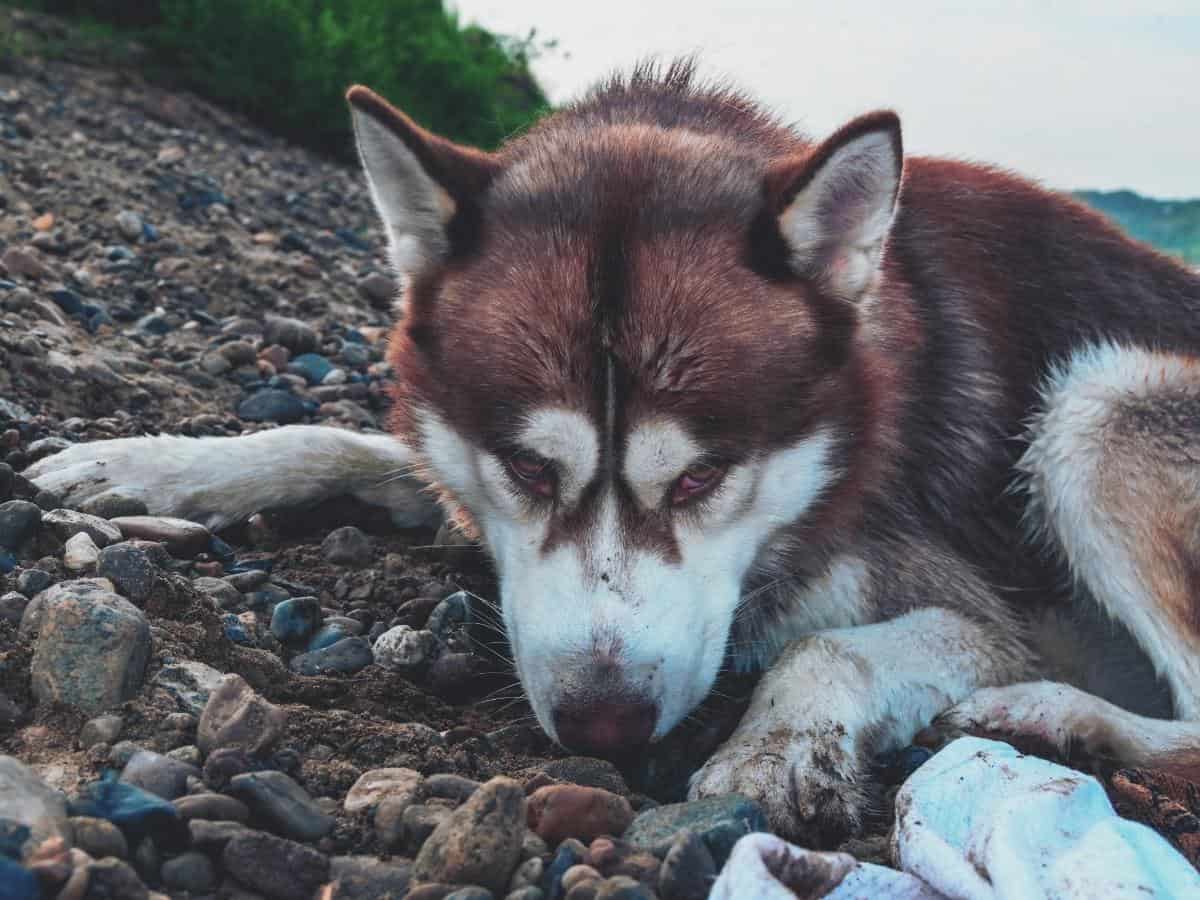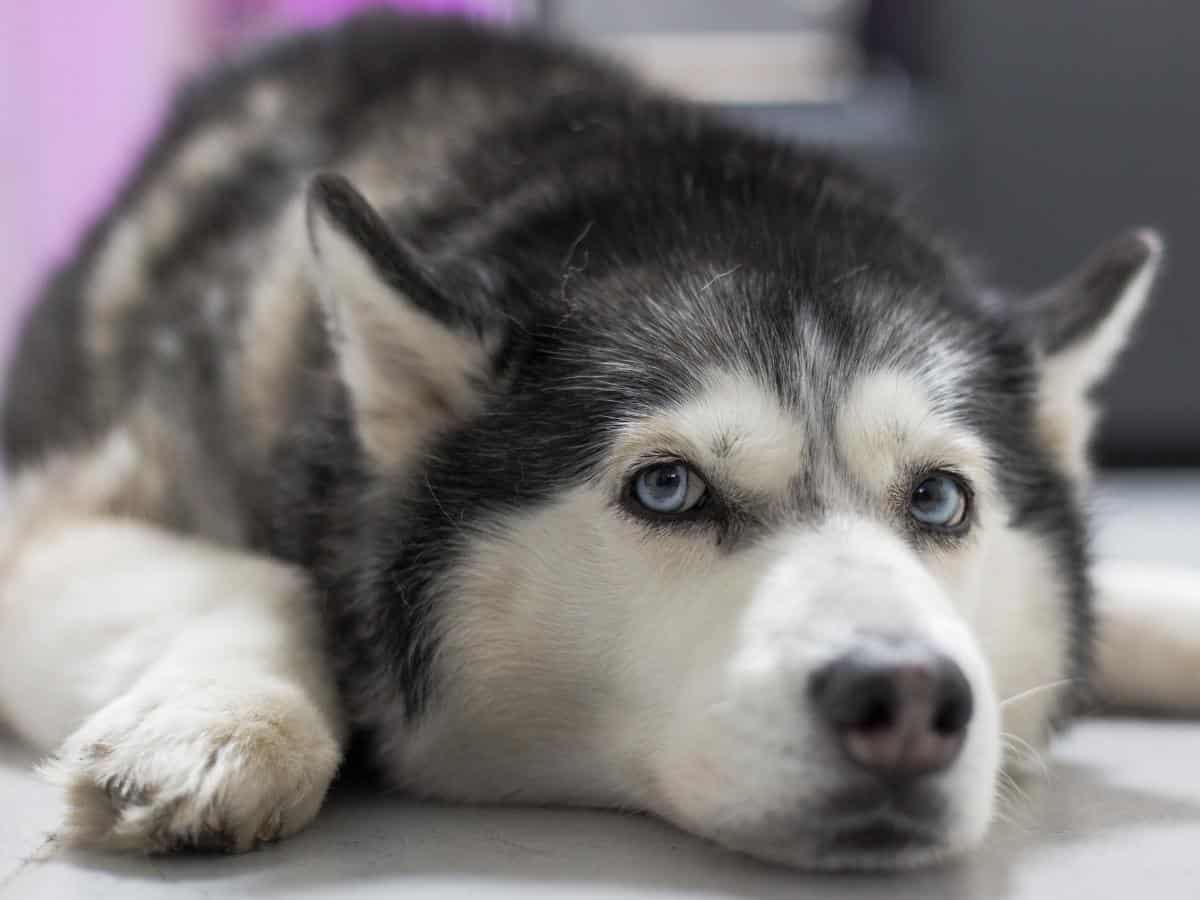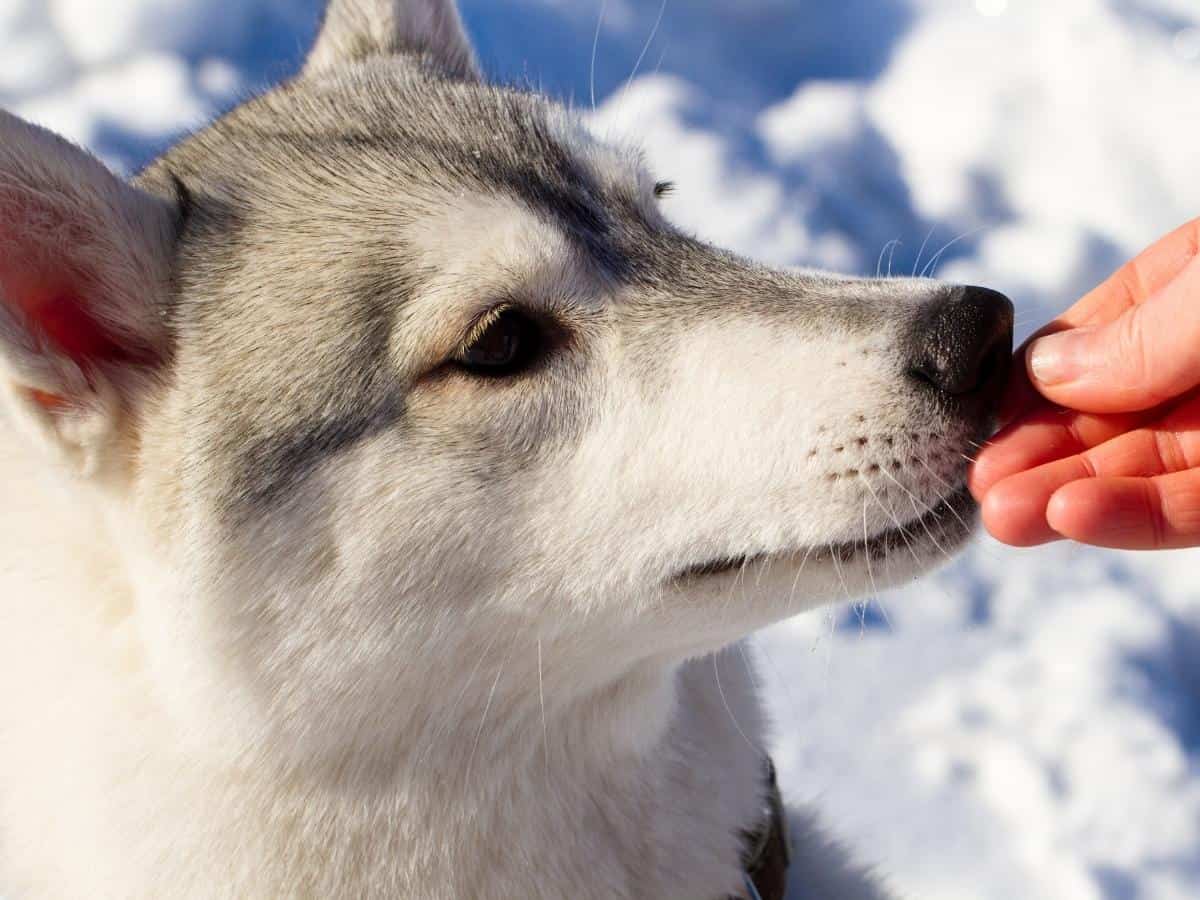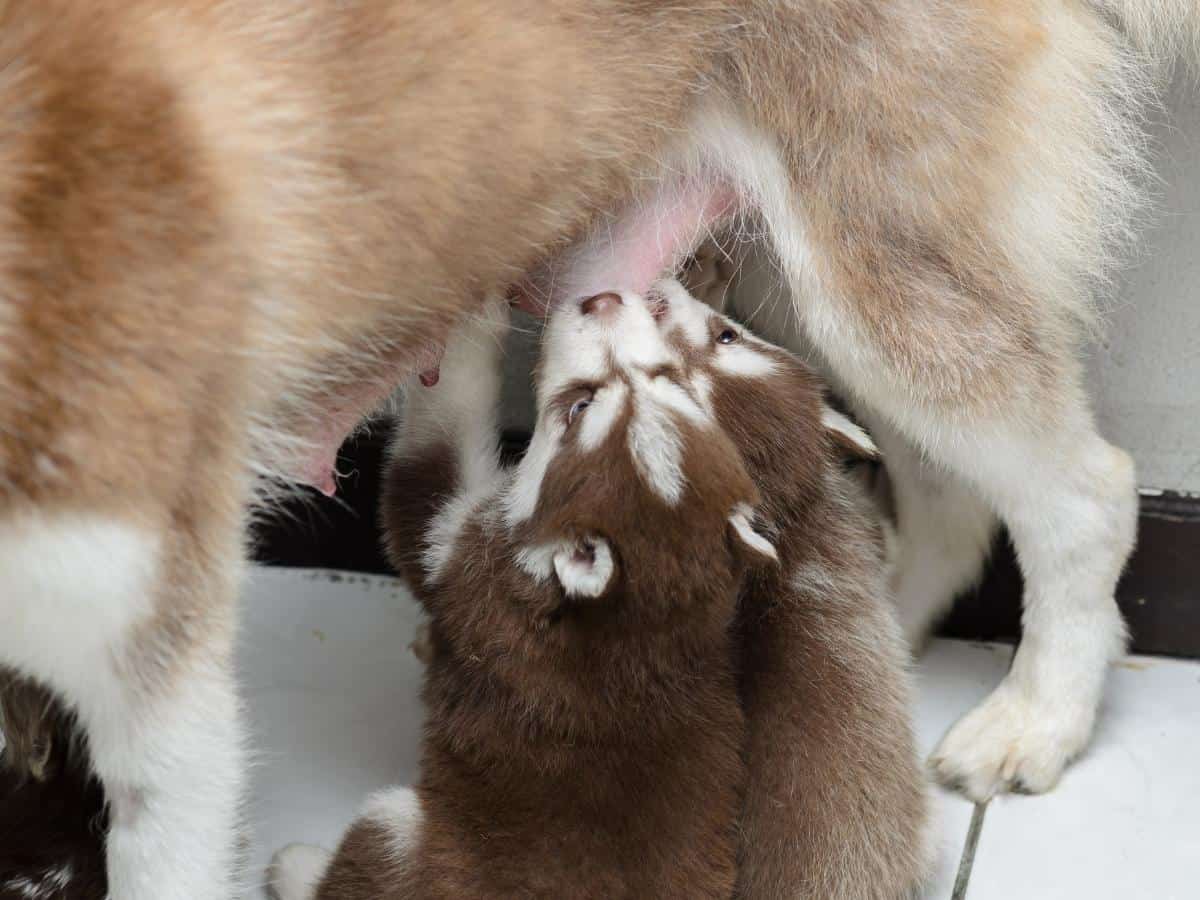If you notice your Husky urinating more than usual, it could cause concern. However, if she is unspayed, this increased urination might actually be an early sign of her first heat.
The onset of a Husky’s first heat is often accompanied by other symptoms, such as a swollen vulva and blood-stained discharge, indicating the beginning of her reproductive cycle.
A Husky typically experiences her first heat between 9 and 12 months of age, marking the initial fertility phase and readiness for mating. Following this, she will enter into heat approximately every six months.
The Husky heat cycle is divided into four distinct phases, with the heat or estrus phase, the most critical for breeding, lasting between 4 to 15 days.
In this blog, we’ll delve into the key aspects of a Siberian Husky’s first heat, covering its timing, signs, and essential care tips.
Whether you’re a new Husky parent or looking to broaden your knowledge, this guide will equip you with the necessary insights to navigate this natural process smoothly and responsibly.
Join us as we dive into everything you need to understand about your Siberian Husky’s first heat cycle.

What Does Husky Heat Cycle Mean?
A Husky’s heat cycle is when a series of hormonal changes occur. The time of first heat marks the onset of fertility, and it’s repeated every six months for the rest of your dog’s life.
While some age-related variations will occur during your dog’s life, a Husky’s reproductive cycle typically happens in four stages.
Proestrus Stage
The proestrus stage in a Husky heat cycle is the initial period of the cycle and lasts around 4-20 days. The following signs characterize this period:
- Frequent urination.
- A darkened lower abdomen.
- Swollen vulva and teats.
- Bleeding, which may be more noticeable in some dogs than others.
- Attracting male dogs, but not necessarily ready to mate.
- Tucking in the tail to cover her vulva and keep away the males.
- “Mood swings” whereby your Husky may become more quiet or anxious.
Huskies can sometimes clean themselves off, making discharge harder to notice. While they can be dramatic about internal changes and pain, they remain relatively clean, so you must pay attention to their temperament and minute changes to spot this stage on time.
Learn All About When Your Dog Is In Heat In This Video…
Estrus Stage
Estrus is the main stage in the Husky heat cycle. It’s the heat period or ‘season’ and the fertile phase of the cycle when ovulation occurs. At this point, your dog is ready to mate.
Estrus lasts between 4 and 15 days and is characterized by the following:
- Seeking out male dogs. If your dog has become more active and aggressive in seeking out other dogs, this could be a sign they are in the Estrus phase.
- Change in the color of the discharge. This is a pinkish/brownish liquid and not the blood-stained discharge of the proestrus stage.
- A ‘flagged’ tail, raised and no longer hiding the vulva. This is a direct indication your Husky is getting ready to mate.
Diestrus Stage
The diestrus phase in a Husky’s heat cycle is marked by a period of rest. If your dog hasn’t conceived during the estrus period, her body will rest in preparation for the next heat season.
Diestrus in Huskies lasts around 60 days. Although your dog may still carry the scent of the heat period, her fertile window has closed at this point.
Anestrus Stage
The last phase of a Husky’s heat cycle is the anestrus stage, which lasts around 90 days. This is the period when your Husky gets ready for her next cycle, which will resume once more with the proestrus stage.
If you’re planning to neuter your Husky, the anestrus period is considered the most opportune time to do so.
My dog Willow was spayed in this stage of her first heat cycle, as advised by her veterinarian.

When Do Huskies Go Into Heat?
Smaller Huskies go into heat when they are around six months old. So, if your Husky is showing the symptoms of being in heat after four months of being adopted, she is highly likely in heat.
But if she is not in heat at six months old, don’t worry. Larger Huskies take longer to come into heat. Most Huskies come into heat by the time they are 9-12 months of age.
Huskies may also come into heat at a much later age. Some Huskies will even go into heat at 18 or 24 months. These variations are all within the norm, and it all depends on your dog.
If your dog is coming into heat, this doesn’t automatically imply that they’re ready for breeding.
In fact, experienced Husky breeders know it’s better to wait until the second heat, preferably the third. This gives them time to come fully into the cycle before breeding.
Mammalian reproduction is quite complex. Like a few other mammals, Huskies are not fully mature for reproduction at their first heat.
A dog’s body is developed enough for healthy gestation by the third cycle. Pregnancy can have a parasitic effect at first heat. Second, heat pregnancy is manageable but burdens the Husky’s body too much.
How Long Does a Husky’s First Heat Last?
A Husky’s first heat lasts between 4 to 15 days and corresponds to the estrus stage of the heat cycle. During these days, your Husky is fertile and can get pregnant if she mates.
However, a female Husky can get pregnant if she mates before the estrus period. This is because canine spermatozoa are motile in the female’s genital tract and can potentially survive for around 11 days.
You may have read that a dog’s first heat and consequent heat seasons last 2-4 weeks. This is because many people consider the heat period to include both the proestrus and the estrus phases of the heat cycle.
However, strictly speaking, a dog’s heat period is the estrus phase. This is when she’s ready to mate and is fertile enough to get pregnant.
How Do You Know When Your Husky Is In Heat?
You’ll know when your Husky is in heat by observing your dog for specific physical and behavioral signs, including:
- A swollen vulva and enlarged teats.
- A change in the color of discharge (pinkish instead of blood-stained).
- Frequent urination.
- A tail set to the side (flagging).
- A loss of appetite.
Huskies can be very visibly interested in male dogs and just as visibly aggressive toward female ones. Depending on how well-socialized they are, they might also have serious anger issues toward humans.
Aside from that, you can notice behavior like urine marking and licking their genitals. Both of these exhibit an interest in mating.
If you have an intact Husky and don’t intend to breed her in this period, you should keep your pet on a leash during walks, as your furry friend will actively seek a sexual partner.

How To Care for a Husky In Heat
When your Husky is in heat, she is going through internal changes that she doesn’t understand.
Since Huskies are sensitive to attention and care (as sled dogs working in a pack are very social and affectionate), you can make your dog feel more comfortable on her journey.
Emotional and physical change can be difficult, but your dog will remember that you were there for her.
Here are 7 things you should do to care for your Husky in heat:
- Keep your dog engaged to distract her from the discomfort of the hormonal changes during the heat period. Playing games, offering treat-filled toys, or taking short walks can help keep your dog happy and calm.
- Keep your Husky away from male dogs at home and outdoors if you don’t intend to breed her. This entails keeping her on a leash during walks, not leaving her unattended in the backyard or garden, and keeping her in a separate room in the home.
- Keep your Husky from carpeted areas of the home, couches, and bedding during the bleeding phase of the heat cycle. Alternatively, you can use dog diapers to stop the blood from staining floors and your dog’s bedding. Choose something like the Simple Solution Disposable Dog Diapers from Amazon. These have a better fit due to the stretchable fabric that fits perfectly around your dog. If your Husky is trying to lick her genitals while in a diaper, consider removing it for some time to give her a chance to self-groom.
- If your Husky shows the need for extra rest, always allow this. It would be best if you also eased your dog’s exercise routine during the proestrus and estrus phases of the heat cycle, as your dog may feel a bit low-energy and under the weather.
- Ensure your dog gets all the recommended nutrients in her meal during heat, including enough fresh drinking water. If your Husky prefers a different meal from the usual, consider giving it to her to boost her appetite. However, you should consult your vet about changing your dog’s diet, even if just for a few meals.
- If your Husky shows extreme discomfort or signs of pain in the swollen vulva, use heating pads to give some relief. I like the RIOGOO Pet Heating Pad as it’s waterproof, machine washable, and has an auto power-off function for extra safety. However, stay alert that your dog doesn’t turn on you abruptly, and consult a vet if the uneasiness or pain doesn’t seem typical.
- Keep the surrounding environment calm and free of extreme noise or disturbance. Your dog is sensitive to any form of stress during this period.
Note: Clicking the above link(s) will take you to Amazon or an online store where we have an affiliate relationship. If you make a purchase, we may earn a commission at no additional cost to you.
Your Husky may show unique characteristics and needs during her heat cycle. Be attentive and consult your vet about any unusual signs you do not know how to address.
Above all, use the environment in your favor. Don’t put your dog in positions where she has to exercise more self-control than she can afford to exercise.
Avoid taking her in crowded places when she is acting aggressively. And give her a safe outlet to use her pent-up energy.
How Often Do Huskies Go Into Heat?
Huskies go into heat twice a year, approximately every six months. This is typical of larger dog breeds, as smaller dogs may go into heat 3-4 times a year, and the largest breeds only once a year.
There’s an approximate 6-month interval between heat cycles in Huskies. An average Husky can be expected to go into heat twice a year for 14 days. Some Huskies’ heat cycle lasts 28 days.
The variation isn’t just in the number of days the cycle lasts but can also cover how frequently the dog goes into heat.
This depends on your dog and her body clock. How often your Husky goes into heat may vary and is contingent upon the following factors:
Age
After a Husky’s first heat cycle, subsequent heat cycles may be irregular initially but will become more consistent with time. If your dog is experiencing irregular cycles, you may want to talk to a vet to determine if this is normal or if there are underlying causes.
Instead, older Huskies will have slowed cycles with fewer heat seasons. Despite this, your dog will still experience estrus her entire life and can get pregnant despite the reduced estrus seasons.
Conception
As happens in humans, gestation delays menstrual periods and fertility seasons. Similarly, dogs’ interestrus interval, or the period between estrus seasons, is prolonged after whelping.
A study on the effects of whelping on 375 dogs of various breeds found that they had a regular 6-month estrus interval under normal circumstances, but the interval was prolonged by an average of 64 days in those dogs who went into gestation.

Seasons
Though seasonality is generally considered a non-factor in estrus frequency in dogs, it is not an impossibility.
This seven-year study investigated the effect of season on reproductive parameters in 53 dogs of various breeds raised under tropical climatic conditions.
Scientists learned that breeding dogs in the summer resulted in a low whelping rate. They found fewer estrus incidences in summer and fewer occurrences of fertility and conception.
FAQs
At What Age Do Female Huskies Get Their Period?
Female Huskies get their periods when they are around six months old. As most breeders release Huskies 2 months after their birth, you can expect your Husky to get her period 14 to 16 weeks after adopting her.
How Long Does a Period Last on a Husky?
A period can last on a Husky for 2 to 4 weeks. Once you notice her vulva returning to normal, you can assume that her period is over. Your Husky’s cycle can vary depending on her proximity to male dogs and age.
Do Huskies Get Period Cramps?
Huskies experience discomfort during their periods, but no conclusive evidence suggests they get cramps like humans. If the experience seems painful, the pet should be handled with care. Your company and kindness can help make her comfortable.
Final Thoughts
When your Husky experiences her first heat, it’s common to mistake the signs for illness. However, as these symptoms progress, it becomes clear that they are natural indicators of her reaching sexual maturity.
Typically, a Husky will go into heat for the first time within the first year of life, usually around the 9th month. Following this initial cycle, she will experience heat approximately twice a year throughout her lifetime.
When caring for your Husky throughout her heat cycle, you must show additional care and comfort during the initial, often uncomfortable phase, referred to as proestrus.
Additionally, it’s essential to keep her separated from male dogs during the estrus stage if she hasn’t been spayed and you’re not intending to breed her.





